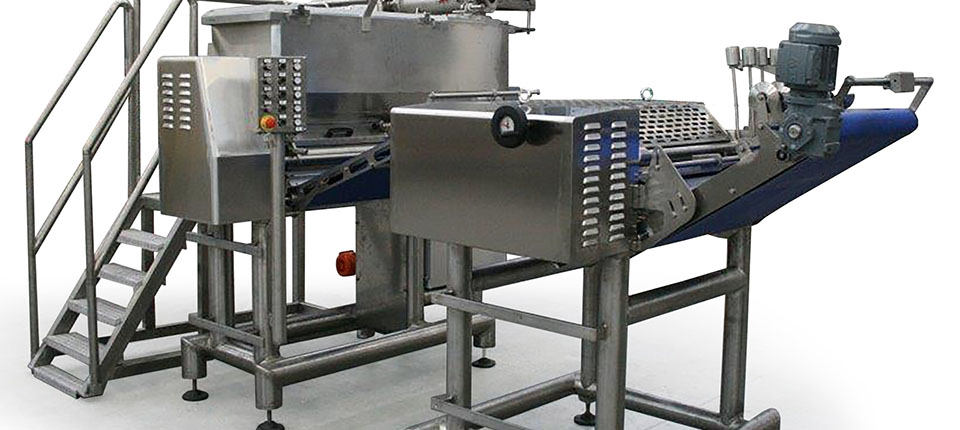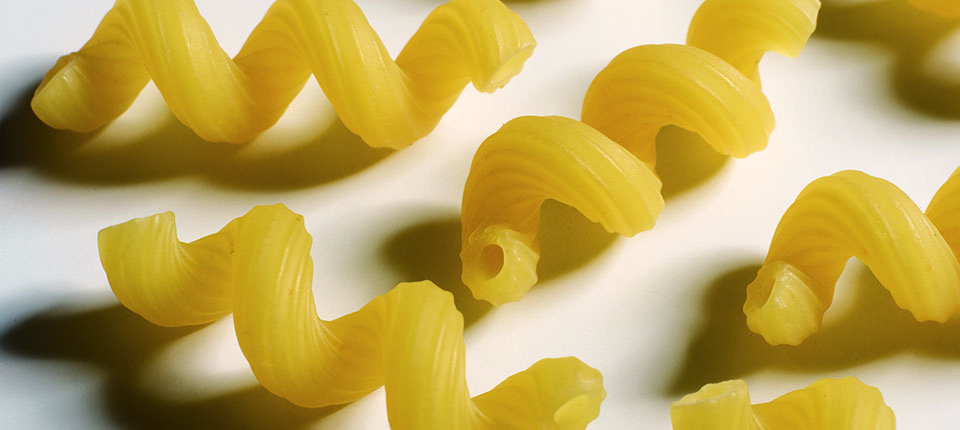
MA-SA model combined kneading machine
9 January 2014The main technical features of the new MA-SA combined kneading machine built by Pasta Technologies Group.
by Pasta Technologies Group
The new combined kneading machine of the MA- SA series is an extremely compact solution that allows the user to execute the initial stages of pasta sheet preparation in a single machine, i.e. dosing ingredients, mixing, kneading and cold working of the sheet.
PTG’s combined kneading machine can successfully be used in a dedicated and customized line, depending on specific customer needs, for example for producing fresh pasta sheets for use in ready meals (such as lasagna and cannelloni ) or for long-cut pasta, not to mention for feeding a filled pasta shaping machine.
Using experience and knowledge gained directly in the field, today PTG is able to offer a solution for preparing a uniformly hydrated and smooth dough, knowing that regardless of the product or shape you want to obtain at the end of the process, success will always depend on the quality of the dough you start out with and its rheological properties, such as elasticity and plasticity .
The correct dosage of the raw materials (semolina, flour, water, plus other ingredients if required in the recipe) makes it possible to obtain a perfectly hydrated, granular type of dough in outfeed from the centrifuge, ready to be remixed and kneaded in the kneading tank until the protein matrix has developed completely.
The sheeter unit works with continuous compression on the mass being processed, but very slowly to avoid overheating the dough and causing heat damage. The compression ratio and lamination index of the sheet are the result of continuous research by PTG and have been tried and tested on many types of dough at Customers’ plants.
The critical aspect in preparing and processing the pasta sheet lies in this sequence of operations which significantly affects the organoleptic and nutritional quality of the end product, as well as its characteristics once cooked, such as its firmness to the bite (al dente quality) and the absence of stickiness on the outer surface of the pasta
Looking at the machine in more detail, the MA-SA combined kneader – sheeter is made entirely of stainless steel and foodsafe plastic material so that it can be washed and sanitized, meeting the strictest international health and hygiene standards in full. The specific technological solutions applied aim to avoid contamination of the product by external agents, i.e. : the double-shoulder structure of the sheeter, which keeps movement and drive components segregated from the processing areas, the electric motors protected by ventilated safeguards, surfaces which are slanted and not horizontal to avoid water collecting and stagnating, the rounded profiles of the support structure, etc. .
Worthy of particular note is the casing which holds the sheeter unit , made as a single piece and shaped to follow the contour of the kneading and lamination rollers, it can be opened with a simple tipping movement, without the need for tools, to provide easy access to even the most hidden areas . This makes it much quicker to carry out inspection, cleaning and maintenance operations.
This feature is perfectly in line with the distinctive decision by PTG to design machines and systems where the use of tools for disassembly and maintenance operations is reduced to a minimum (if not, as in some cases, eliminated altogether) to avoid having to bring tools into the processing areas near to where the fresh product transits.
The working movement of the sheeter is controlled by a single planetary gearmotor which, in a very small space, can transmit high motor torque values at low rpm levels.
Drive is controlled with a frequency regulator or a VSD and a system for controlling the speed of the sheet in machine outfeed. In this way it is possible to produce the sheet in full automatic mode and provide a constant supply for the machines installed downline from the sheeter.
In its standard configuration , the MA- SA combined kneader is made up of the following units to knead and work the fresh sheet:
• a volumetric, auger-type semolina and flour dosing unit for regular dosing of powdered and granulated products, alternatively a version is available with a gravimetric dosing unit with loading cells for even greater precision and reliable dosing;
• one or more micro dosing units, as required, for dosing micro-ingredients (dehydrated vegetable, flavourings, etc.). to be added to the dough in accordance with the quantities set in the recipe;
• water feeding system, complete with all the necessary measuring and control accessories, for automatically adding water to the dough in the proportions required and at the right temperature and pressure conditions;
• controlled feeding system for pasteurized and refrigerated liquid egg , complete with connection system, measuring accessories and designed for execution of automatic C.I.P. washing cycles;
• centrifuge unit for high-speed mixing (centrifugal effect) of all the previously dosed raw materials and subsequent unloading of the mixture into the kneading unit;
• a continuous kneader that evenly kneads the premix with shaped blades, complete with level control in the tank to guarantee continuous production;
• a state-of-the-art sheeter which, thanks to the combined action of shaped rollers ( kneading rollers ) and smooth rollers, compacts the dough to create an even and uniform pasta sheet of the desired width and with a thickness of about 6-8 mm ;
• a stainless steel service platform, mounted on casters, for easy and safe access to parts located at a height, such as the kneading tank and the series of dosing units;
• a scrap recovery system that picks up the pasta offcuts resulting from cutting the sheets to size and takes them back to the kneader to be reincorporated into the dough. A high-speed fan is also used with blades to cut and chop the recovered scraps into small pieces. This can be opened for quick and efficient cleaning even of the most inner parts.
The machine comes with its own electrical panel complete with dedicated PLC board for controlling working conditions in automatic mode, such as the recipe number , kg/h production, the percentage of raw materials and micro-ingredients and the lamination speed in the dough sheeter, and display them all on an operative touch-screen interface panel . Via the screen, the operator can quickly find values such as energy absorption and electric motor speed , the opening/closure percentage of the valves, as well as see various error and warning messages, scheduled maintenance reminders, etc.
A central RAM unit will record all this data collected during production and store the data history in a database and archive file or, for easier reference, in trend and graph displays for a specific time variable.
Keep reading, download the magazine
 PASTARIA DE (digital edition) 2013 n. 6 (ITALIANO) (16.2 MiB, 2,753 download)
PASTARIA DE (digital edition) 2013 n. 6 (ITALIANO) (16.2 MiB, 2,753 download)
Registrazione necessaria. Sign-up to download.
 PASTARIA INTERNATIONAL DE (digital edition) 2013 n. 6 (ENGLISH) (19.7 MiB, 1,324 download)
PASTARIA INTERNATIONAL DE (digital edition) 2013 n. 6 (ENGLISH) (19.7 MiB, 1,324 download)
Registrazione necessaria. Sign-up to download.


